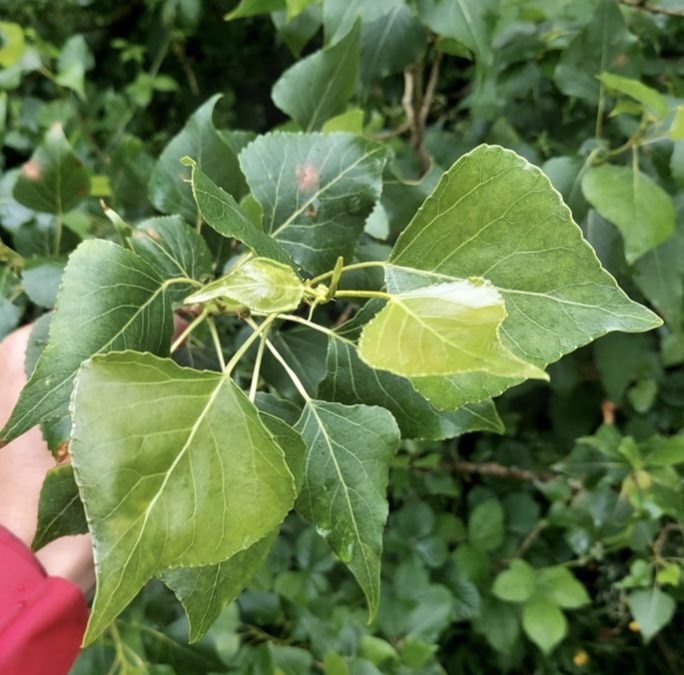Populus nigra subsp. betulifolia, commonly known as the native black poplar, is one of the rarest and most iconic tree species in the UK. A subspecies of the European black poplar (Populus nigra), it is distinguishable by its broad leaves, twisted branches, and deeply fissured bark. This majestic tree has long been associated with lowland floodplains, particularly thriving in areas with moist, fertile soils.
Natural Range in the UK and Europe
The native black poplar is found primarily across the British Isles and western France. Historically, it flourished along riverbanks and floodplains, favouring wet woodland edge habitats, meadows, and areas prone to seasonal flooding. The trees were planted historically as markers of county and parish boundaries resulting in trees being panted in hedgerows, this suited this species with it being a light demanding tree avoiding competition from other large trees. Its range has significantly diminished over the centuries due to the draining of the wetlands and conversion of land to farmland. In Europe, the black poplar (Populus nigra) can be found from southern France to central and eastern Europe, with the betulifolia subspecies confined to the western edges of the continent, particularly in the UK and parts of western France.
Estimated Current Numbers in the UK
The native black poplar is now one of Britain’s rarest native trees, with estimates suggesting fewer than 7,000 mature specimens remain in the wild with only an estimated 10% of these being female. The drainage of wetlands and loss of natural habitat has been especially damaging to the tree numbers as the seeds of this tree require wet soil for the seed to land in and the soil must remain moist for the seed to germinate. The species readily hybridises with the American populus deltoides, resulting in a large number of hybrids being present throughout the UK. Many of the true native black poplars are isolated individuals, scattered across various counties such as Bedfordshire, Shropshire, and Cheshire, making it difficult for natural regeneration to occur. This isolation, combined with habitat loss, has pushed the tree to the brink of extinction in the wild.
How to identify Native Black Poplar
Identifying this tree can be very difficult as there are various cultivars of this tree which may or may not have some of the same characteristics of the native black.
If you do try and make this identification then the tree must have all of the below to be considered:
1) The trunk must be leaning
2) The bark must be very fissured and have at least some burr like structures
3) The main branches must sweep down from the main stem with the twigs seeping upwards.
4) The shoots must be round in cross section
5) When the leaves emerge they must be green or very slightly red.
6) The leaves must have no glands at the base of the leaf
7) The terminal bud must be sticky and exude sticky yellow substance
8) Very few leaf hairs are present on the margins
9) Twigs and petioles are hairy, but be aware there may be some glabrous twigs and petioles on the same tree
10) The teeth on the leaf margins are not hooked
11) Spiral Gauls are usually present
12) No mistletoe will be present in this species
13) Rare that sucker growth from the roots will be present
14) The buds tend to point outwards.
Ecological Value
Despite its scarcity, the black poplar plays a crucial role in its ecosystem. As a pioneer species, it helps stabilise riverbanks and floodplains, reducing soil erosion and improving water quality. Its large canopy offers valuable shade and shelter for a variety of wildlife, including birds and insects. The decaying wood of older trees provides a habitat for invertebrates, fungi, and other organisms that rely on rotting wood for survival.
In particular, the black poplar supports specialist species such as the poplar hawk moth and the poplar leaf beetle. Its presence also contributes to the overall biodiversity of wetland ecosystems, which are among the most threatened habitats in the UK.
Threats to the Species
The decline of P. nigra subsp. betulifolia can be attributed to several factors, with habitat loss being the most significant. The drainage of wetlands for agriculture, urban development, and changes in river management have drastically reduced the natural floodplain habitats where the tree once thrived. Furthermore, the lack of genetic diversity within the remaining population poses a major risk, as isolated trees struggle to reproduce naturally. Hybridisation with non-native poplars introduced from Europe and North America has further diluted the genetic purity of the native black poplar, making it increasingly rare.
Climate change presents another long-term threat. Changes in rainfall patterns and rising temperatures could further degrade the tree’s natural habitat, while increasing frequency of extreme weather events may damage the already fragile population.
Hopes for the Future of the Native Black Poplar
Despite these challenges, there is hope for the future of the native black poplar. Conservation efforts are underway across the UK to protect and restore the species. Programs such as the Black Poplar Working Group and initiatives led by wildlife trusts focus on planting new trees from genetically verified stock, ensuring that new generations of P. nigra subsp. betulifolia are preserved. Habitat restoration projects, such as re-wilding and the re-creation of wetland areas, aim to provide suitable environments for the species to thrive.
With continued conservation efforts and increased awareness of its importance, there is hope that the black poplar can be brought back from the brink of extinction, ensuring that future generations can enjoy the presence of this unique and ecologically valuable tree.

